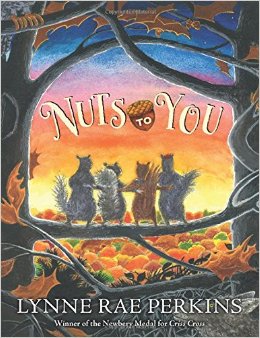Fall 2014 Publishers’ Preview: Five Questions for Lynne Rae Perkins
This interview originally appeared in the September/October 2014 Horn Book Magazine as part of the Fall Publishers’ Preview, a semiannual advertising supplement that allows participating publishers a chance to each highlight a book from its current list.
This interview originally appeared in the September/October 2014 Horn Book Magazine as part of the Fall Publishers’ Preview, a semiannual advertising supplement that allows participating publishers a chance to each highlight a book from its current list. They choose the books; we ask the questions.
Sponsored by![]()
Newbery Medalist Lynne Rae Perkins’s Nuts to You was published in August by Greenwillow Books.
 Photo: Lucy Perkins.
Photo: Lucy Perkins.1. Your fellow Newbery laureates Lois Lowry, Cynthia Voigt, and Richard Peck crossed over into animal fantasy with books about mice. What’s with the squirrels?
LRP: I was working in my studio one afternoon when, out of nowhere, the phrase “the squirrel who cried wolf” popped into my head. I couldn’t stop laughing when I thought of it. After some time (weeks? months?) went by and I still thought it was funny, I wrote a little story about it. Which grew and grew and grew.
2. Did writing fantasy teach you anything about writing realism?
LRP: At the risk of sounding really dumb, until you asked this question, I never mentally categorized this book as “fantasy,” though clearly it is. I did think of it as my attempt at joining the great tradition of rodent adventure novels, which I believe allow us to see ourselves without getting too scared or having our feelings hurt. But all kinds of fiction is about character and relationships and circumstances. And language.
 3. And what have you learned about squirrels?
3. And what have you learned about squirrels?LRP: So many things! There are recorded instances of mass squirrel emigrations that include swimming across lakes and reservoirs. They use the dog paddle stroke. They cause a lot of power outages, usually when one part of them is touching something grounded and another part is touching something that’s not grounded. Bad for us, bad for them.
4. As the rare writer who illustrates her own novels, how do you decide what gets a picture?
LRP: Some ideas are visual first — cinematic, even — then verbal. Sometimes images form in my mind while I’m writing, and then I want to draw them. So, in this book, I was on the lookout for situations that would lend themselves to simple yet expressive or dramatic compositions.
5. Your squirrels don’t know why they’re losing their trees. Where would fiction be without ignorance?
LRP: How often do we sit reading a book or watching a movie, silently shouting, “Just tell him, for crying out loud!” But then the story would be over. In real life, there is so much that we don’t or can’t know. We are always guessing. Maybe that’s why we like watching fictional characters struggling with that same dilemma.
Sponsored by![]()
RELATED
RECOMMENDED
ALREADY A SUBSCRIBER? LOG IN
We are currently offering this content for free. Sign up now to activate your personal profile, where you can save articles for future viewing.








Add Comment :-
Be the first reader to comment.
Comment Policy:
Comment should not be empty !!!